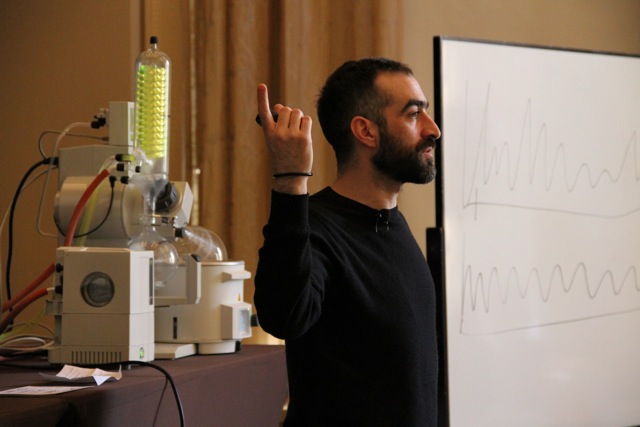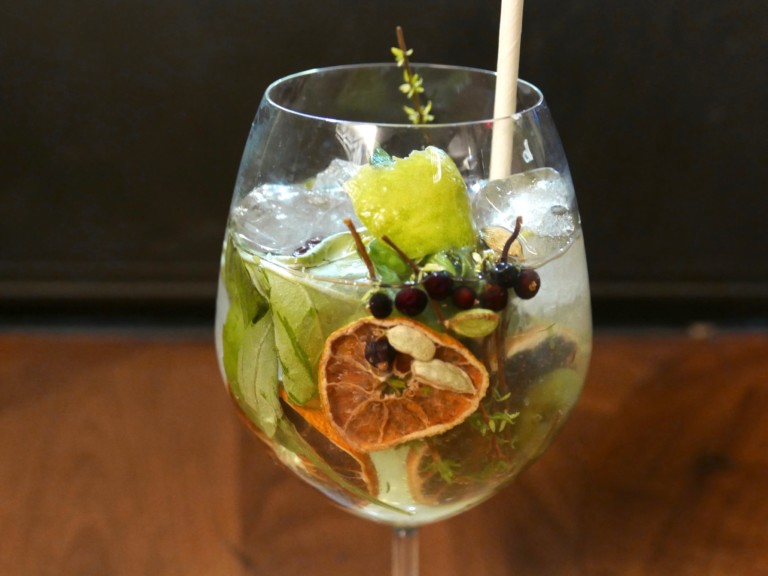Pernod Ricard USA invited L.A. area bartenders and media types like me to the W Hotel Hollywood on March 28 to learn from the Pioneers in Mixology.
In a massive hotel meeting space, Gary Regan introduced British legends like Tony Conigliaro, Simon Ford, Nick Strangeway and Chris Edwardes, who all imparted spirited knowledge throughout the course of the day. I was most interested in Conigliaro, who trained under British legend Dick Bradsell, now runs progressive establishments like 69 Colebrooke Row, and who Regan called “a mad scientist, he’s a crazy motherfucker, and a man who shows us what can be done as opposed to what has been done.”
Conigliaro is involved in the cutting-edge Drink Factory, a London collective that utilizes equipment like the rotovap to push the limits of technique and flavor. He schooled the audience on his methods, beginning with a primer on 69 Colebrooke Row, a 35-seat bar that was born from his love of going to meticulous Tokyo bars. The downstairs remains “about service, about the customer, and about producing quality drinks, rather than bamboozling people with science.” Until recently, a Drink Factory lab resided upstairs, though it recently moved. Conigliaro said that with Drink Factory, ”We don’t just work with people in our industry, we try to go out as far as possible and see what comes back in.” The collective allows perfumers, designers, bartenders and chefs to collaborate.
Conigliaro started by discussing Aroma, pointing out that alcohol and cocktails share history with perfumery, since “alchemists use to distill things.” He said, “We always thought there was a smell associated with sours that we called wet dog’s nose, which is the result of the reaction of the alcohol with egg whites.” Since eggs are semi permeable and receptive to osmosis, he shared hard-boiled eggs infused with cut grass essence. Conigliaro adds the hay eggs to a Calvados sour. Wet dog’s nose, be gone.
Conigliaro noticed, “When you spray perfume on a wrist, you get sharp alcohol notes, which dissipates very quickly.” Drink Factory started making their own perfumes with food-grade essences like jasmine and tuberose. “What you get on the cocktail is the sweet smell of rose,” he said. “I like the way this drink evolves and becomes a story of a rose as opposed to a rose note.” Hydrosol allows bartenders to suspend the essential oils of an ingredient in water without the ingredient breaking down.
The rotovap allows people to distill at very low temperatures. Conigliaro pointed out, “At the top of Mt. Everest, if you boiled water, it would boil at 154.4 Fahrenheit, 300mBar (barometric pressure).” The Buchi rotovapor machine allows users to reach as low as 10 mBar…”which allows to not damage ingredients we’re putting through, delicate things like orange flowers, which if you put through, the structure would break down.” The colder the temperature, the less breakdown. He distilled horseradish vodka at 40 degrees, 92 mBar. Water normally boils at 212 degrees, 1000 mBar.
The horseradish vodka, distilled in Chicago, retains “sulfury notes, the earthy notes, it’s got the notes all the way through,” and apparently works beautifully in a bloody Mary. Flint stone is captures the smokiness of the stone and imparts a “minearally white wine” note into cocktails. Conigliaro distills delicate herbs and flowers at a very low temperature to be able to capture everything. He said the process is still trial and error, but Conigliaro is currently writing a Buchi manual for chefs and bartenders.
Conigliaro discussed the Various Distillations: Straight, Hydrosol, Alcohol, Salt, Separations and Reductions. He discussed two compelling examples. In a Blood and Sand cocktail, he’ll remove water from oranges “to make it stand up better in the drink.” More incredibly, “You can pull certain notes out of [corked] wine…Take that note out so you can drink it.”
Why do ingredients go together? Conigliaro posed that question to the crowd and explained that scientifically, certain ingredients have chemical overlaps. “Citrus goes together because if you get a lemon and a lime, they have a really high amount of chemicals that are very similar…they’re about 95% the same.” He turned to Bernard Lahousse at Foodpairing, who “wanted to know why things work together.”
Blackberries, grapes and red wine have overlap. So do olive oil and cardamom. He pointed out that strawberry and American bourbon have very few links, but if you add “bridges,” they meld. For example, Basil and Iberico ham need a bridge of gin.
Conigliaro also discussed the concept of aging cocktails, which he first did with Manhattans. He put down a Manhattan in wood and bottles and discovered, “The wood ones died very quickly. They got very oxidized and very woody. From the sixth month something happened, they opened, they blossomed, they’d become richer and deeper. I got very very excited and put down 48 bottles.” In 2010, he opened the first bottle and “it was just absolutely incredible.” A friend in Switzerland had a gas chromatograph, so Drink Factory tested what was happening, and they discovered, “The peaks and troughs were a lot smaller, and there were a lot more chemicals…breaking down in the bottles to create new aromas and new flavors.” Conigliaro and his team are putting down 48 bottles every three months, and once a year, they sell one aged Manhattan to each interested customer. A 7-year Manhattan sells for $25. Conigliaro said, it’s not about, “We’ve got this thing. It’s about sharing the experience, communicating our joy to the customer.”
He started putting cocktails through a rotovapor machine, including an unstirred Manhattan. “take the wood notes out of it and put staves in the bottle with a controlled amount of air…then I could age it with wood…Take the wood out of it, but it’s got the robust bourbon-y flavors.” Drink Factory also did Harvards and El Presidentes, which “work really, really well, phenomenally well.”









Leave a Comment